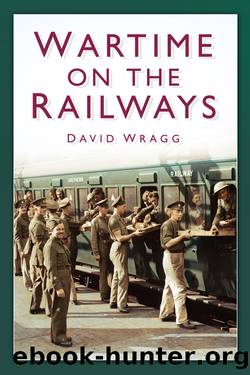Wartime on the Railways by David Wragg

Author:David Wragg [Wragg, David]
Language: eng
Format: epub
ISBN: 9780752489209
Publisher: The History Press
Published: 2012-09-11T14:00:00+00:00
PASSENGER ROLLING STOCK
Wartime construction of new passenger rolling stock virtually ceased due to the austerity drive. Nevertheless, the Great Western was allowed to complete the final stage of its railcar programme, largely because work was too far advanced and much of the equipment, such as the engines, had already been built. In any case, diesel railcars required a third less manpower in operation, and much less in maintenance, than did steam trains, even as steam railmotors. The Southern Railway was also allowed to build two units of a new class of suburban electric multiple unit, on which the design work had been started before the war, but these were to a new severe utility specification, although not quite as bad as some of the wartime utility-bodied buses which had wooden seats.
While services were cut back in wartime, the Southern Railway had been suffering capacity problems even before the outbreak of war on its suburban services. To alleviate overcrowding, the first step was to convert a large number of three-car units to four cars by using trailer carriages from electric multiple units mothballed as a result of the wartime reductions in frequencies.
Limited construction of a new class of suburban electric rolling stock was permitted. Initially undesignated, but later becoming known as 4 SUB, these were of all-metal construction using welded and curved body sides to increase capacity. The first appeared early in 1941, with two motor coaches having a motormanâs compartment, a guardâs compartment and nine third-class compartments each with seats for twelve passengers, a trailer with two third-, six first- and two third-class compartments, with the first-class compartments each having ten seats, and another trailer with eleven third-class compartments. Overall accommodation was for sixty first-class and 396 third-class passengers. Later that year, by which time all London suburban services had become third class only by official decree, a second set appeared with third-class seating throughout, giving a total of 468 seats, indicating that the numbers of compartments and their dimensions were the same as on the original, so that conversion back to first- and third-class accommodation was envisaged after the war. This was all that was allowed for the time being, but a further seven sets were built to this specification between January and April 1945, by which time new construction was becoming acceptable again.
Download
This site does not store any files on its server. We only index and link to content provided by other sites. Please contact the content providers to delete copyright contents if any and email us, we'll remove relevant links or contents immediately.
| Automotive | Engineering |
| Transportation |
Whiskies Galore by Ian Buxton(41885)
Introduction to Aircraft Design (Cambridge Aerospace Series) by John P. Fielding(33064)
Small Unmanned Fixed-wing Aircraft Design by Andrew J. Keane Andras Sobester James P. Scanlan & András Sóbester & James P. Scanlan(32744)
Craft Beer for the Homebrewer by Michael Agnew(18145)
Turbulence by E. J. Noyes(7942)
The Complete Stick Figure Physics Tutorials by Allen Sarah(7310)
Kaplan MCAT General Chemistry Review by Kaplan(6868)
The Thirst by Nesbo Jo(6832)
Bad Blood by John Carreyrou(6558)
Modelling of Convective Heat and Mass Transfer in Rotating Flows by Igor V. Shevchuk(6392)
Learning SQL by Alan Beaulieu(6213)
Weapons of Math Destruction by Cathy O'Neil(6151)
Man-made Catastrophes and Risk Information Concealment by Dmitry Chernov & Didier Sornette(5926)
Digital Minimalism by Cal Newport;(5667)
Life 3.0: Being Human in the Age of Artificial Intelligence by Tegmark Max(5478)
iGen by Jean M. Twenge(5367)
Secrets of Antigravity Propulsion: Tesla, UFOs, and Classified Aerospace Technology by Ph.D. Paul A. Laviolette(5311)
Design of Trajectory Optimization Approach for Space Maneuver Vehicle Skip Entry Problems by Runqi Chai & Al Savvaris & Antonios Tsourdos & Senchun Chai(5012)
Pale Blue Dot by Carl Sagan(4916)
